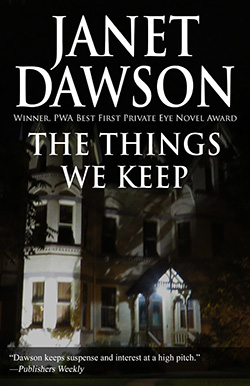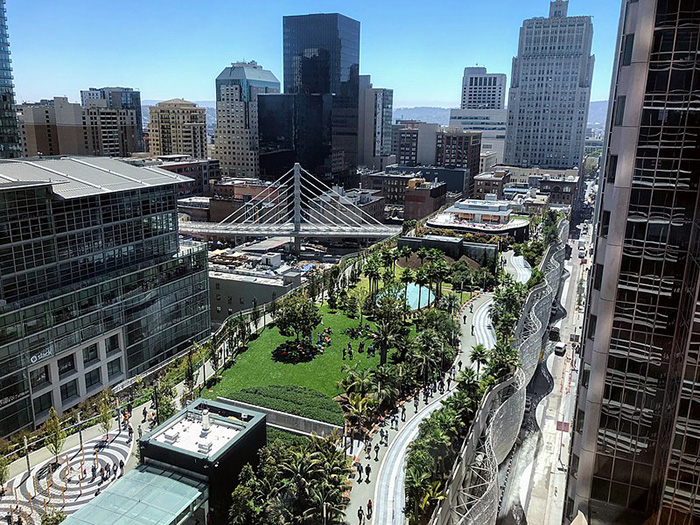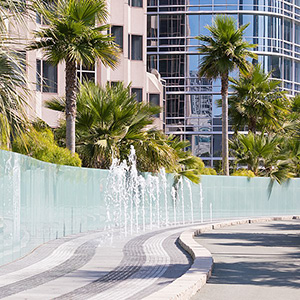
“Longtime fans of Janet Dawson will be delighted in this latest installment of their favorite private detective’s adventures… New readers to the series can also easily dive into this fun adventure that takes them back to San Francisco in its heyday… From start to finish this is a compelling mystery with a private detective who has lost none of her trademark wit, intelligence, or investigative skills.”
—Cynthia Chow, Kings River Life
“The kind of private investigator novel I’m always hoping to read… an absorbing story, a complex PI novel.”
—Lesa Holstine, Lesa’s Book Critiques
Jeri is all over the map. Yes, if you’ve read the Jeri Howard series, you know that Jeri is based in Oakland, California. But this private investigator doesn’t just stay in the office. She goes places. All over the nine counties that encompass the greater Bay Area, of course.
And certainly farther afield. In Don’t Turn Your Back on the Ocean, a brief vacation in Monterey turns into a case and Jeri travels south to San Luis Obispo. A Credible Threat takes her to Colorado, then north to Mendocino. In Where the Bodies are Buried, Jeri follows a lead to Carlsbad, New Mexico. Bit Player leads her to Los Angeles, then over the Sierra Nevada to Lee Vining and Mono Lake. The Devil Close Behind finds her in New Orleans. In Witness to Evil, she goes all the way to Paris, then winds up in Bakersfield.
Most of the time, though, Jeri stays close to home. Oakland, Alameda, San Francisco, up to Marin and Sonoma counties.
Jeri’s latest case is The Things We Keep. The book begins in Alameda, the island city, where Jeri grew up. It’s full of old Victorian-era homes and Jeri is in one such house when she finds two skulls and a pile of bones in an old Navy footlocker. As the footlocker implies, the house is close to the Alameda Naval Air Station.

(Photo: Dicklyon, Wikimedia Commons)
Let’s see what Jeri has to say about that location, as she heads to the old air station to follow a lead:
This site on Alameda’s west end had once been wetlands, filled in 1927 to create an airport. In 1936, the city ceded the land to the federal government. Construction of the Naval Air Station began in 1940. In 1941 came Pearl Harbor and the American entry into World War II. Fleet Air Wing 8 began scouting and patrol missions here, and in 1942, the aircraft carrier USS Hornet loaded up the planes that would be used in the Doolittle raid on Tokyo. NAS Alameda was a bustling presence in the Bay Area, all through World War II, the Korean War and into the Vietnam era and beyond. At one time, five aircraft carriers were anchored here. In addition to the huge military population, thousands of civilian employees worked here as well, doing everything from overhauling aircraft to staffing administrative positions to running the cash registers at the Navy Exchange and the commissary.
At the end of the Cold War, the Base Realignment and Closure (BARC) commission added the air station to the list of more than 300 military bases that would be closed. Eventually the land was turned over to the city of Alameda and the site was named Alameda Point. Redevelopment was in the works, with plenty of fits and starts. Sometimes proposals went nowhere and in other cases, the land and the buildings had been given over to new uses.
I turned right on Main Street, which took me past the old commissary, where military personnel and their families had shopped for groceries. The building, long empty, looked as though it was falling apart. Weeds had pried their way through cracks in the asphalt, threatening to take over the entire parking lot. . . . . When I got out of my car, I stood for a moment, listening to the seagulls cry as they circled overhead. I imagined the sounds I would have heard back in the days when the air station was home to ships and squadrons, with the blasts of ship horns and the scream of jet engines, the thrum of rotating propellers and clanking of anchor chains.
At another point in the book, Jeri heads over to San Francisco, tracking down someone who may have information. When she gets of BART, she heads into the area called South of Market. It used to be—well, I’ll let her tell you:
This area close to the bay had once been Rincon Hill, one of the original seven hills that made up San Francisco. The neighborhood had beautiful views and a sunny climate, and soon was full of fashionable homes. That didn’t last. In 1869, the Second Street cut sliced through the hill to give access to the south waterfront and its surrounding industrial areas. The canyon resulting from the cut was a hundred feet deep, cleaving Rincon Hill, destabilizing the homes that remained. The neighborhood deteriorated. The fashionable section of San Francisco moved to the north of Market Street, where elegant mansions rose on Nob Hill. The 1906 earthquake leveled what remained of the Rincon Hill neighborhood. The San Francisco anchorage of the Bay Bridge, constructed in the 1930s, stands atop what’s left, as did the old Embarcadero Freeway.

(Photo: Fullmetal2887, Wikimedia Commons)
Jeri finds the person she’s looking for and follows him, all the way to the city’s new transit center and the park on top:

(Photo: Frank Schulenburg, Wikimedia Commons)
The old Transbay Terminal, where busses from all over the Bay Area had converged on San Francisco, wasn’t there anymore. The old building had been designed by architect Timothy Pflueger, who’d also designed two of the East Bay’s opulent Art Deco movie palaces, the Alameda Theatre and Oakland’s Paramount. The 1939 building was rundown by the time it was damaged in the 1989 Loma Prieta earthquake. It was demolished and a shiny new transit center rose to replace it. Right now it contained an aboveground bus terminal and empty subterranean tunnels that were supposed to house tracks for CalTrain, the commuter rail that ran down the Peninsula, and the high speed rail line that was being built to link the Bay Area with Los Angeles. It seemed the latter option was far in the future, but the terminal was here and now.
One of the transit center’s best features was a 5.4 acre rooftop park, located five stories above the street. It had a walking trail, a play area for kids, and a small amphitheater for events. The landscaping featured a desert garden at the western end and a wetlands garden at the east. There were bird walks, garden tours, and regular activities for children. Then there was the bus fountain, where sensors built into the bus deck below triggered 247 geysers, an innovative work of public art. No wonder the park was so popular with residents and workers alike.
Jeri follows another lead to the western part of Marin County:
The Point Reyes National Seashore is one of my favorite places to visit, great for hiking, birding, watching elephant seals at Chimney Rock or Drake’s Beach, looking for migrating whales from the lighthouse. The Pacific Ocean forms the western boundary, while the east side of the point is long, narrow Tomales Bay, where the San Andreas fault runs into the ocean.
The small, unincorporated town of Point Reyes Station is here, above the marshes of Tomales Bay. Highway One, the Pacific Coast Highway, runs through it. At the junction, I turned left onto the highway and followed it into town, where another left turn took me into the heart of the small business district. The Bovine Bakery sign triggered a strong desire for one of the bakery’s delectable morning buns. Though I suspected that in the middle of the day, all the morning buns would be gone.

(Photo: Miguel.v, Wikimedia Commons)
Excerpt from Chapter One
“It looks haunted.”
I stood on the sidewalk, looking at the old Victorian house on the corner. Like many others in Alameda, it had been built in that era from 1880 to the early twentieth century, in a style known as the Queen Anne, which often featured bay windows and turrets.
This particular house, however, was a Queen Anne gone rogue, screaming excess. It had a large bay window that jutted out from one side of the front porch, towers and turrets galore, plus a surfeit of roof finials, wall carvings and other elaborate gewgaws. There were several stained glass windows, one above the front door and others on the side of the house.
Dan, my fiancé, shut the driver’s side door and pressed the key fob to lock the car. “It has a general air of neglect, but I don’t see any ghosts hovering in the upstairs windows.”
“They wouldn’t lurk during daylight hours.”
I knew the ghosts were there, lurking, waiting to make their presence known. I had a feeling this old house had secrets, lots of them.
It was the middle of October. Earlier this month, a fire to the north blew smoke into the Bay Area, sending air quality into the unhealthy range and turning skies a dirty orange, the smell of smoke everywhere. The fire had been contained and the wind blew away the smoke and the ash. I had washed off the dirty gray residue that had coated my car and my patio furniture. Today, Saturday, was warm, but not too warm. The sky was bright blue with a dusting of white clouds.
A few blocks away, the Alameda Farmers Market was in full swing. A young couple walked by, the father pushing a stroller containing an infant, the mother with a toddler in tow, telling him they were going to buy apples and grapes at the market. On the other side of the street, a woman headed home, carrying a bouquet of yellow chrysanthemums and a canvas bag with a head of romaine lettuce peeking from the top.
A dog barked. I glanced to my left, where a shaggy brown mutt strained at the leash, eager to go after the fat squirrel that was halfway down the trunk of a nearby oak tree. The squirrel chittered and changed its trajectory, climbing back up into the branches. The dog yipped its disappointment as the man at the other end of the leash tugged it away.
Dan and I crossed the street. He was right about the general air of neglect. It didn’t take long for a house to acquire that patina of disrepair. The owner had moved out a month or so ago. But it looked as though exterior maintenance had been deferred far too long. The windows, especially those of stained glass, were dirty and several panes had cracks. The wooden siding had been painted different colors over the years, sometimes several colors at once. Peeling layers showed green, yellow, red and even purple. Right now the exterior was a faded blue, the trim olive green. It looked like the roof could do with some work as well.
There were several rose bushes close to the house, all with spent blooms in need of deadheading. The front and side yards featured native plants and succulents instead of grass, with bark and gravel spread out around them to keep down the weeds. But weeds are persistent and they were making inroads. A lemon tree in the front yard had fruit showing bright yellow amid the green leaves. The ground below was littered with fallen lemons, some rotting, which contributed to the house’s abandoned look.
At some point in the past the house, like so many of the Victorians in Alameda, had been converted from a single-family home to a multi-unit apartment building, with meters for gas and electricity arrayed on one side of the house, and covered conduits for wiring crawling up the side. A wooden stand at the foot of the front steps held four black mailboxes with locks, each with a brass letter denoting the units, A through D. Two upstairs, I guessed, glancing at the second-floor windows. Maybe two more units on the first floor. But the house also had a ground level unit, its windows shielded by horizontal blinds. I glanced up the cracked and bumpy concrete driveway on the right side of the house. Way at the back, I saw a detached garage big enough for two cars.
On the other side of the driveway, another Victorian house appeared to be empty. It sported a FOR SALE sign. So did the one beyond it, with a smaller sign tacked on above, reading SALE PENDING.
A blue Honda sedan was parked in the Queen Anne’s driveway. It belonged to our friends, Noel Benjamin and his wife, Lakshmi Srinivasan. We were here to help them go through the house and inventory its contents. That job had been sweetened by their promise of dinner at the day’s end, since their kids were spending the weekend with Lakshmi’s parents in Fremont.
Dan and I climbed the steps to the front porch, which was decorated with big terra cotta pots on either side of the front door, both planted with bronze chrysanthemums in need of watering. A small signboard to the left of the door was meant to list the names of the people who lived in the apartments, but all four slots were empty.
Dan pushed the doorbell. A moment later, the door opened and Noel Benjamin waved us into the hallway. He was a wiry man in his thirties, brown hair receding from a high forehead, with a sharp wedge of a nose. Laugh lines crinkled around his hazel eyes as he smiled at us. Like Dan and me, he wore faded jeans and a T-shirt, ready for what would no doubt be a messy task.
“Come in. And let me tell you again how much I appreciate this. Lakshmi’s in the kitchen making coffee. We brought pastries, so we’ll have a nosh before we get started.”
We stepped into the foyer. The hardwood floors were oak, scuffed and stained with years of wear, cracks here and there between floorboards, some of them wide enough to swallow coins or a key. The staircase on the right had a wooden banister and a faded green stair runner. To the left was a closed pocket door. The ceramic plaque on the wall next to it, in bright orange and blue, bore the letter A.
Between the staircase and the pocket door, a hallway led back to another door that opened onto a large kitchen, the walls and cabinets painted a pale green. The vinyl tile on the floor had a green and yellow pattern. In the center of the room was an oval table with metal legs and a yellow Formica top, the kind popular back in the 1950s and now sought by people who liked mid-twentieth century furniture. The countertops were also yellow Formica. There was a built-in dishwasher to the left of the sink. The white refrigerator and the smooth-topped stove looked fairly new, as did the side-by-side washer and dryer in one corner.
Several cardboard boxes sat on the floor, filled with the items common to most kitchens—a set of stainless steel pans, a cookie sheet, several mismatched bowls of varying sizes, and a handheld mixer. An assortment of utensils, everything from wooden spoons to spatulas, filled a smaller box. Donations, I guessed, along with a basket that held placemats, napkins and pot holders. Canned goods and packaged food filled another box.
Lakshmi smiled as she turned to greet us. She was a slender woman in her thirties, casually dressed, her long black hair caught back in a ponytail, her wide eyes brown in an oval face. “The coffee is almost ready. We need to fortify ourselves for the task ahead. I’ve brought pastries for now, and cheese, fruit and nibbles for later.”
On this side of the sink, the counter held a coffeemaker, sputtering as strong black brew dripped into the glass carafe. Next to this were four mismatched ceramic mugs, a pint carton of half and half, and a pink bakery box.
I poured a mugful of coffee and moved to the pastry box, making my selection. “Cheese danish. Works for me.”
“I’ve been picking up lemons. And veggies from the garden out back.” Lakshmi pointed at two large paper sacks on the floor near the stove. One held an assortment of squash and tomatoes, and the other bright yellow lemons of varying sizes. “Please, take some home with you. There’s no point in letting them go to waste.”
“Thanks, I will. I have plenty of squash and tomatoes in my own garden, but I’m always in the market for lemons. I use them in cooking.” I pulled out a chair and sat at the kitchen table, which had metal-legged chairs, the seats covered with yellow vinyl that was nearly a match for the table surface.
“Bear claw,” Dan said cheerfully, claiming his favorite pastry. He and the others joined me at the table.
Dan writes books about hiking, focusing on different states and regions. Noel and Lakshmi own and operate a small local publishing company. Together they acquire a variety of books. Noel takes care of the financial end of the business, as well as production, while Lakshmi edits books and does the marketing. Their small press is located here in Alameda and so is their home, a bungalow on the East End, where they live with their two children. I’d met them when Dan and I had dinner at their home during the summer.
I glanced across the table at Noel. “This is quite a house. It belongs to your aunt?”
Noel set his coffee mug next to his cherry danish and smiled. “Aunt Gloria, yes. Great-aunt, really. She’s my grandmother’s sister. We’ve gotten close over the years, since Lakshmi and I live here in Alameda. As Gloria has gotten older, she’s come to rely on us. Older, but not really that old these days. Grandma and Gloria are in their late seventies. Both active and engaged with the world. They’re twins, by the way. But nothing alike. My grandmother is quiet and conservative. Gloria, on the other hand, is a character.” He laughed. “She’s a free spirit. Never been married, and she’s had a colorful life, judging from her stories.”
As Noel talked, I glanced at Lakshmi. The look on her face told me she had heard the colorful stories too many times. My guess was that Lakshmi didn’t much like Aunt Gloria, but tolerated her for Noel’s sake.
“Gloria lived in San Francisco in the sixties,” Lakshmi said, pulling apart her almond croissant. “In the Haight. Ground zero for hippiedom and the music scene. To hear her tell it, she hung out with everyone from Janis Joplin to the Grateful Dead.”
Noel was nodding. “She was lead singer for a band in those days. I don’t remember which one. I don’t think they ever got to be famous. Then she bought this place in nineteen sixty-nine.”
“A move to strait-laced, conservative Alameda?” I chuckled. “After rock ’n rolling in the Haight? That’s quite a change.”
“I don’t know what prompted that move, way back when,” Noel said. “Maybe it was chance to do something different. This place was a good investment, still is. It was originally a single family home, then converted to flats during World War Two. Through the years, she rented apartments to sailors from the Naval Air Station and students from the College of Alameda. The base closed, of course, but the college is still here. This is a great location, just a few blocks to Webster Street and several bus lines. Not that far to the ferry terminal either.” He paused as he took a bite from his danish and washed it down with coffee. “Around the end of August, six weeks ago, Gloria decided to give up this place and move into a senior apartment. It was a surprise, really. And this all happened really fast.”
“What about the tenants?” Dan asked. “The place doesn’t look lived in. Did she stop renting out the units?”
“There are no tenants.” Lakshmi frowned. “Which is odd, because Gloria always had renters. She priced the apartments on the low side, so she could keep the units full. But the renters moved out, all within the last couple of months.”
“That is unusual,” I said. “Particularly if she was charging lower rents than market rate. Rents are going up like crazy, all over the Bay Area. I’m glad I bought my house when I did.”
Noel shrugged. “People move on. I think the renters leaving at about the same time is just the luck of the draw. Gloria said the man who lived in one of the upstairs apartments moved out of the area. I don’t know about the other two tenants.”
“I was surprised that the woman who lived in the ground level unit left,” Lakshmi said. “She had been here ten years or more. She’s the one who created the vegetable garden out back. I thought she was settled in for another ten years, but suddenly in August, she packed up and moved out. I don’t even know if she gave thirty days’ notice.”
“That’s strange, given how long she was here,” I said. “Maybe she found a better place to live. Or there could have been a problem here.”
“If there was a problem, Gloria didn’t say what it was. I just . . .” Lakshmi hesitated. “I think there’s something odd about the way the tenants left.”
So did I. “Did Gloria list the apartments and not get any takers?”
Lakshmi shook her head. “No, it turns out she didn’t list them. I asked her why and she said she’d decided to move. That was the first I’d heard of it. Her decision seemed to come out of the blue.” She toyed with the handle of her coffee mug. “Gloria always insisted she could age in place here. She’s owned this house for decades, living in the first-floor unit and renting out the other apartments. She was vocal about living here until they carried her out. No senior apartment or assisted living for her.”
“What changed her mind?”
“She fell,” Noel said. “Here in the kitchen.”